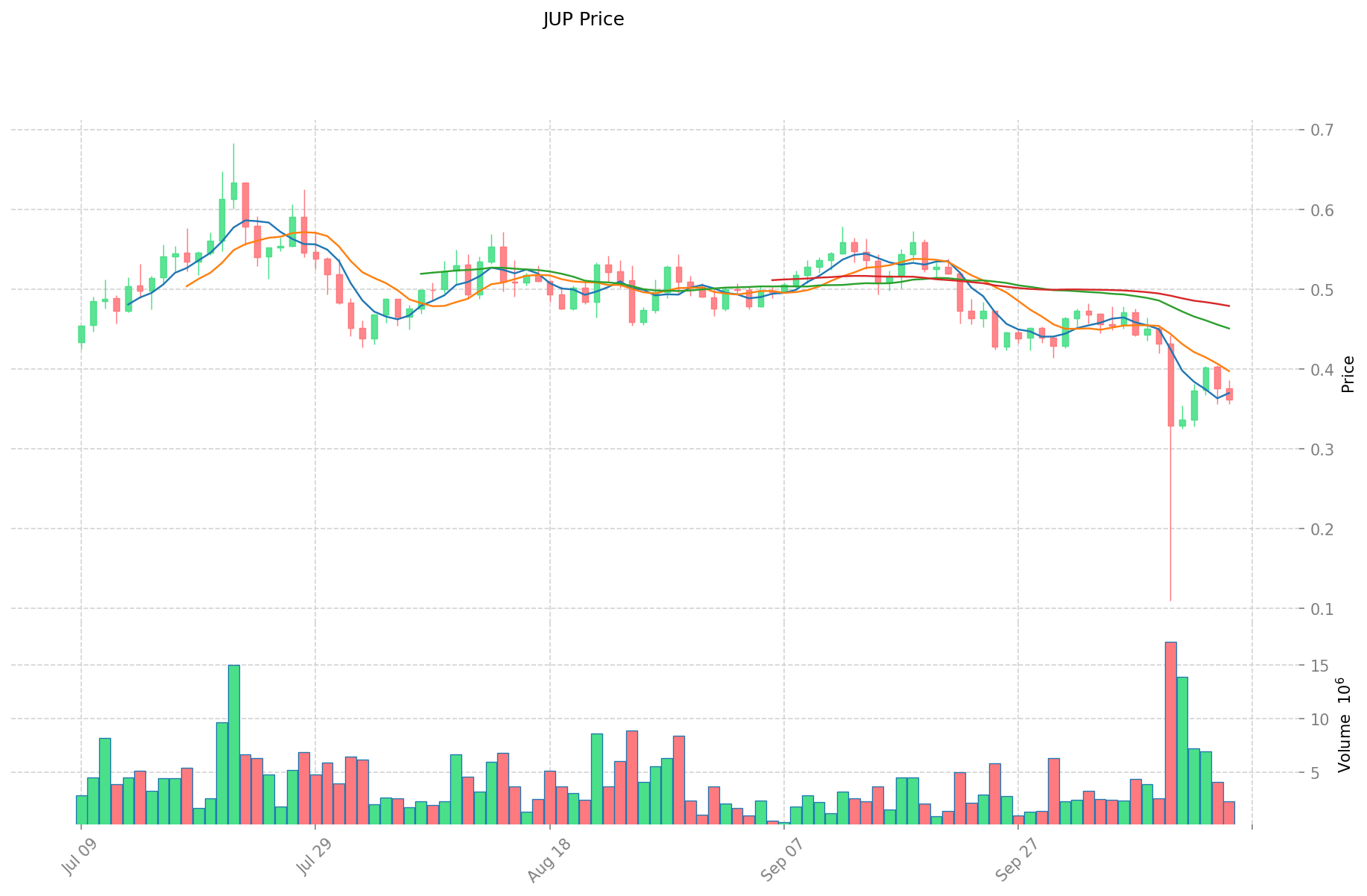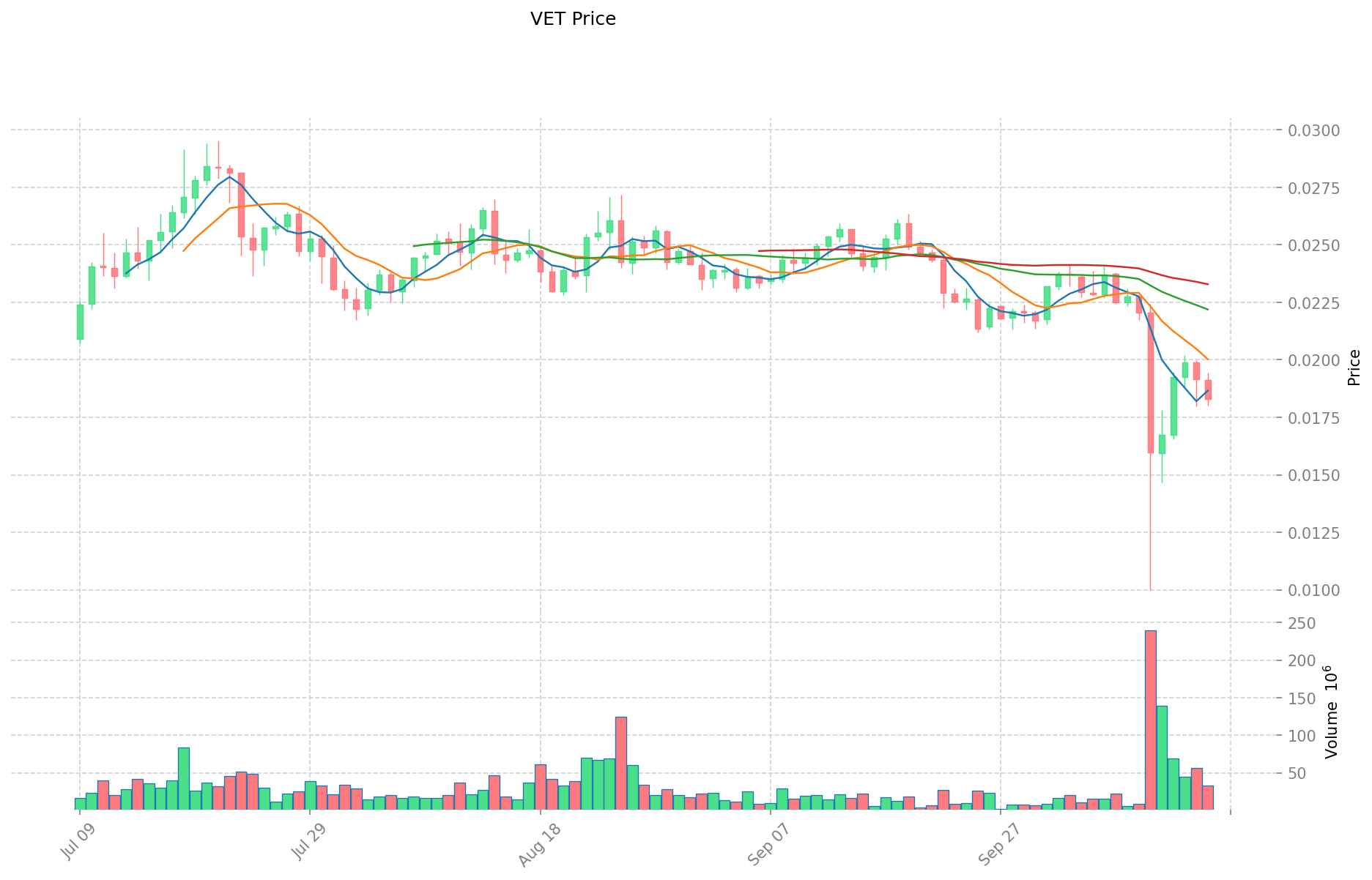JUP vs VET: A Comparative Analysis of Two Emerging Cryptocurrencies in the Digital Asset Space
Introduction: JUP vs VET Investment Comparison
In the cryptocurrency market, the comparison between Jupiter (JUP) and VeChain (VET) has been an unavoidable topic for investors. The two not only differ significantly in market cap ranking, application scenarios, and price performance but also represent different positions in the crypto asset landscape.
Jupiter (JUP): Since its launch, it has gained market recognition as Solana's primary liquidity infrastructure, driving more than 80% of the total retail liquidity movement on the network.
VeChain (VET): Introduced in 2017, it has been hailed as a blockchain platform for supply chain management and business processes, aiming to create a trusted distributed business environment.
This article will provide a comprehensive analysis of the investment value comparison between JUP and VET, focusing on historical price trends, supply mechanisms, institutional adoption, technological ecosystems, and future predictions, attempting to answer the question investors care about most:
"Which is the better buy right now?"
I. Price History Comparison and Current Market Status
JUP and VET Historical Price Trends
- 2024: JUP reached its all-time high of $2.2 due to increased adoption of Solana's DeFi ecosystem.
- 2025: VET experienced a downturn, with its price dropping to $0.01833, affected by overall market conditions.
- Comparative analysis: During the recent market cycle, JUP dropped from its peak of $2.2 to a low of $0.1097, while VET showed less volatility, maintaining a relatively stable price range.
Current Market Situation (2025-10-16)
- JUP current price: $0.3602
- VET current price: $0.01833
- 24-hour trading volume: JUP $845,181.85 vs VET $609,014.71
- Market sentiment index (Fear & Greed Index): 34 (Fear)
Click to view real-time prices:
- Check JUP current price Market Price
- Check VET current price Market Price


II. Core Factors Affecting JUP vs VET Investment Value
Supply Mechanism Comparison (Tokenomics)
- JUP: Limited token supply, creating potential scarcity value
- VET: Two-token system with VET and VTHO, designed for enterprise use
- 📌 Historical pattern: Supply mechanisms influence price volatility in both cryptocurrencies
Institutional Adoption and Market Applications
- Institutional holdings: Both tokens show varying levels of institutional interest
- Enterprise adoption: VET has stronger enterprise partnerships for supply chain solutions
- Regulatory attitudes: Different regulatory approaches across countries affect trading and adoption
Technical Development and Ecosystem Building
- JUP technical upgrades: Focus on DeFi functionality and cross-chain capabilities
- VET technical development: Emphasis on supply chain solutions and enterprise blockchain applications
- Ecosystem comparison: VET has more established enterprise applications while JUP focuses on DeFi infrastructure
Macroeconomic Factors and Market Cycles
- Performance in inflationary environments: Both cryptocurrencies subject to high volatility
- Macroeconomic monetary policy: Interest rates and USD index influence cryptocurrency markets broadly
- Geopolitical factors: Cross-border transaction demands affect adoption potential
III. 2025-2030 Price Prediction: JUP vs VET
Short-term Prediction (2025)
- JUP: Conservative $0.21-$0.36 | Optimistic $0.36-$0.47
- VET: Conservative $0.018-$0.018 | Optimistic $0.018-$0.021
Mid-term Prediction (2027)
- JUP may enter a growth phase, with expected price range $0.33-$0.55
- VET may enter a steady growth phase, with expected price range $0.013-$0.029
- Key drivers: Institutional capital inflow, ETF, ecosystem development
Long-term Prediction (2030)
- JUP: Base scenario $0.62-$0.65 | Optimistic scenario $0.65-$0.67
- VET: Base scenario $0.025-$0.034 | Optimistic scenario $0.034-$0.044
Disclaimer: This analysis is for informational purposes only and should not be considered as financial advice. Cryptocurrency markets are highly volatile and unpredictable. Always conduct your own research before making any investment decisions.
JUP:
| 年份 | 预测最高价 | 预测平均价格 | 预测最低价 | 涨跌幅 |
|---|---|---|---|---|
| 2025 | 0.46917 | 0.3609 | 0.212931 | 0 |
| 2026 | 0.5727483 | 0.415035 | 0.3652308 | 15 |
| 2027 | 0.553158648 | 0.49389165 | 0.3309074055 | 37 |
| 2028 | 0.58634816688 | 0.523525149 | 0.39787911324 | 45 |
| 2029 | 0.7547138547984 | 0.55493665794 | 0.5160910918842 | 54 |
| 2030 | 0.674470014060276 | 0.6548252563692 | 0.62208399355074 | 81 |
VET:
| 年份 | 预测最高价 | 预测平均价格 | 预测最低价 | 涨跌幅 |
|---|---|---|---|---|
| 2025 | 0.0209076 | 0.01834 | 0.0177898 | 0 |
| 2026 | 0.02354856 | 0.0196238 | 0.018446372 | 7 |
| 2027 | 0.0289254812 | 0.02158618 | 0.0131675698 | 17 |
| 2028 | 0.03409537131 | 0.0252558306 | 0.015658614972 | 37 |
| 2029 | 0.03768801321285 | 0.029675600955 | 0.02759830888815 | 61 |
| 2030 | 0.044459985350781 | 0.033681807083925 | 0.024924537242104 | 83 |
IV. Investment Strategy Comparison: JUP vs VET
Long-term vs Short-term Investment Strategies
- JUP: Suitable for investors focused on DeFi ecosystem potential and Solana network growth
- VET: Suitable for investors interested in supply chain solutions and enterprise blockchain adoption
Risk Management and Asset Allocation
- Conservative investors: JUP: 30% vs VET: 70%
- Aggressive investors: JUP: 60% vs VET: 40%
- Hedging tools: Stablecoin allocation, options, cross-currency portfolio
V. Potential Risk Comparison
Market Risks
- JUP: High volatility due to its connection with Solana ecosystem
- VET: Susceptible to overall crypto market trends and enterprise adoption rates
Technical Risks
- JUP: Scalability, network stability dependent on Solana
- VET: Centralization concerns, potential security vulnerabilities
Regulatory Risks
- Global regulatory policies may have differing impacts on both tokens
VI. Conclusion: Which Is the Better Buy?
📌 Investment Value Summary:
- JUP advantages: Strong position in Solana's DeFi ecosystem, potential for rapid growth
- VET advantages: Established enterprise partnerships, real-world supply chain applications
✅ Investment Advice:
- New investors: Consider a balanced approach, leaning towards VET for its established use cases
- Experienced investors: Explore JUP for higher growth potential, while maintaining a diversified portfolio
- Institutional investors: Evaluate both based on risk tolerance and alignment with investment goals
⚠️ Risk Warning: Cryptocurrency markets are highly volatile. This article does not constitute investment advice. None
FAQ
Q1: What are the main differences between JUP and VET? A: JUP is Solana's primary liquidity infrastructure, driving over 80% of retail liquidity on the network. VET is a blockchain platform for supply chain management and business processes. JUP focuses on DeFi functionality, while VET emphasizes enterprise blockchain applications.
Q2: How do the current prices and market situations of JUP and VET compare? A: As of 2025-10-16, JUP's price is $0.3602, while VET's price is $0.01833. JUP's 24-hour trading volume is $845,181.85, compared to VET's $609,014.71. The market sentiment index is at 34, indicating fear.
Q3: What are the key factors affecting the investment value of JUP and VET? A: Key factors include supply mechanisms, institutional adoption, market applications, technical development, ecosystem building, and macroeconomic factors such as inflation and geopolitical events.
Q4: How do the long-term price predictions for JUP and VET compare? A: By 2030, JUP's base scenario price range is predicted to be $0.62-$0.65, with an optimistic scenario of $0.65-$0.67. For VET, the base scenario is $0.025-$0.034, with an optimistic scenario of $0.034-$0.044.
Q5: What are the recommended investment strategies for JUP and VET? A: For conservative investors, a 30% JUP to 70% VET ratio is suggested. For aggressive investors, a 60% JUP to 40% VET ratio is recommended. It's important to consider individual risk tolerance and investment goals.
Q6: What are the potential risks associated with investing in JUP and VET? A: Risks include market volatility, technical challenges (scalability for JUP, centralization concerns for VET), and regulatory uncertainties that may impact both tokens differently.
Q7: Which cryptocurrency might be considered a better buy? A: The choice depends on the investor's profile. New investors might lean towards VET for its established use cases, while experienced investors might explore JUP for higher growth potential. Institutional investors should evaluate both based on risk tolerance and investment goals.
Share
Content